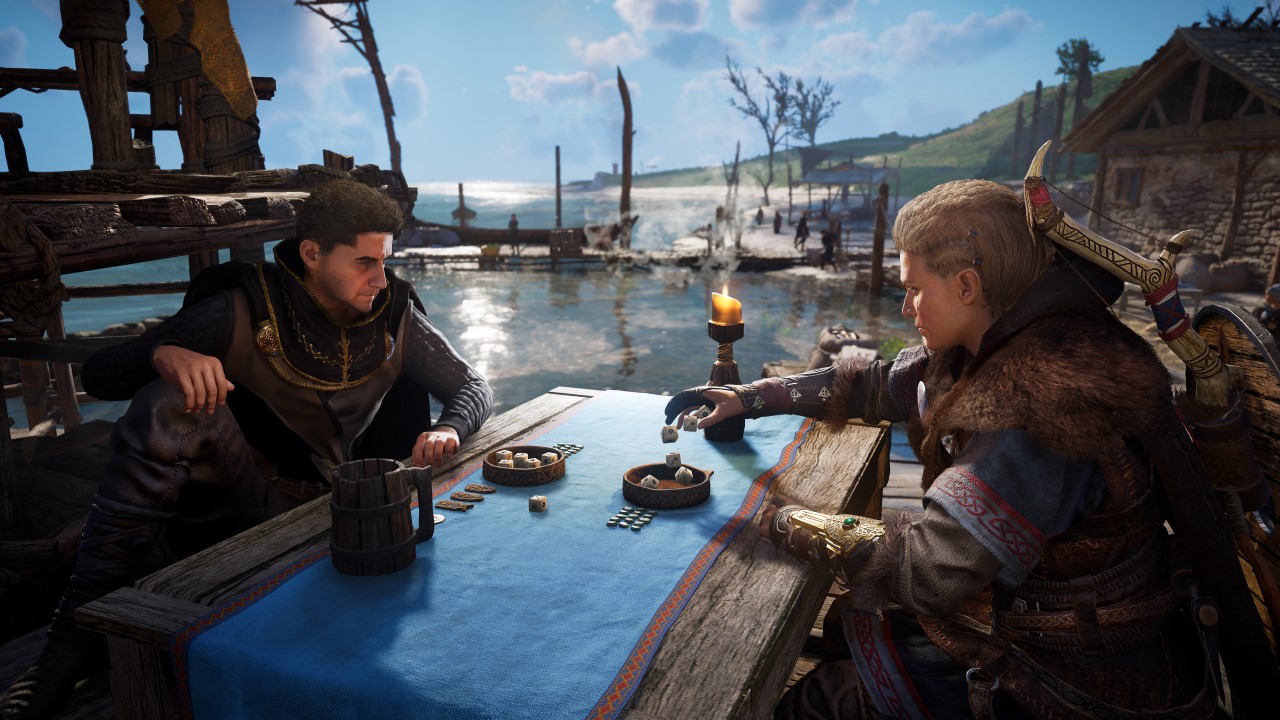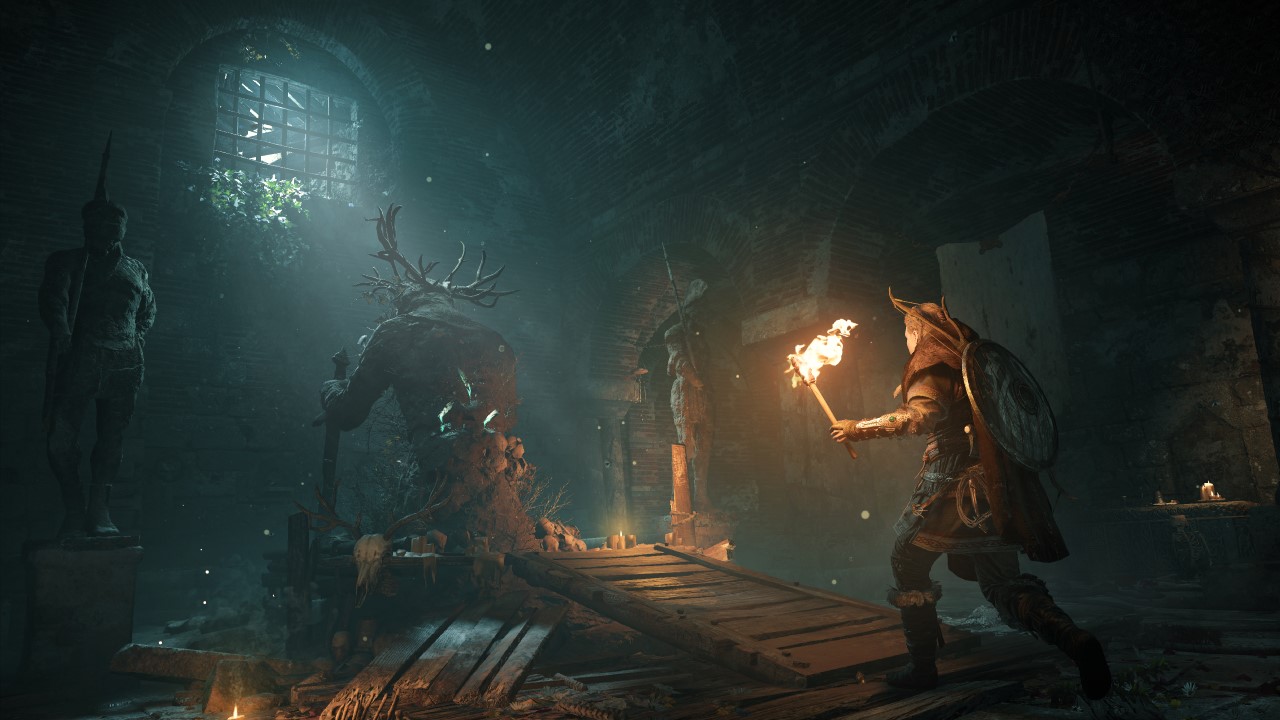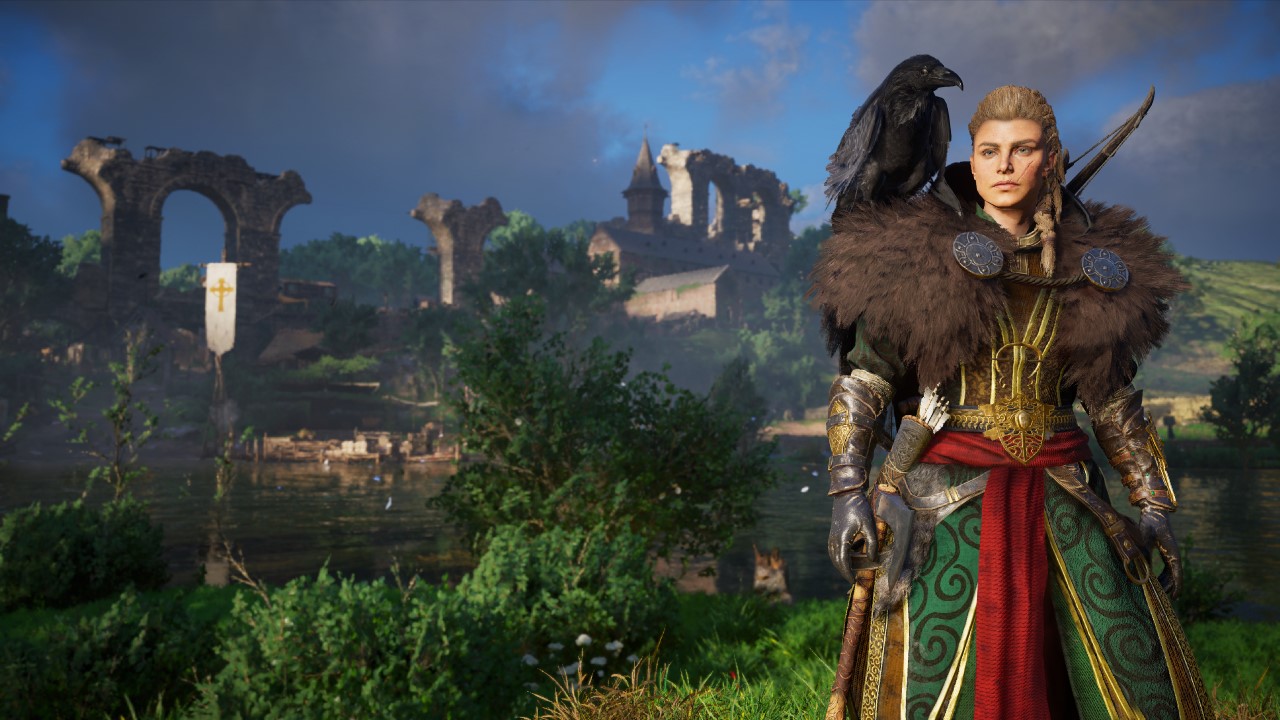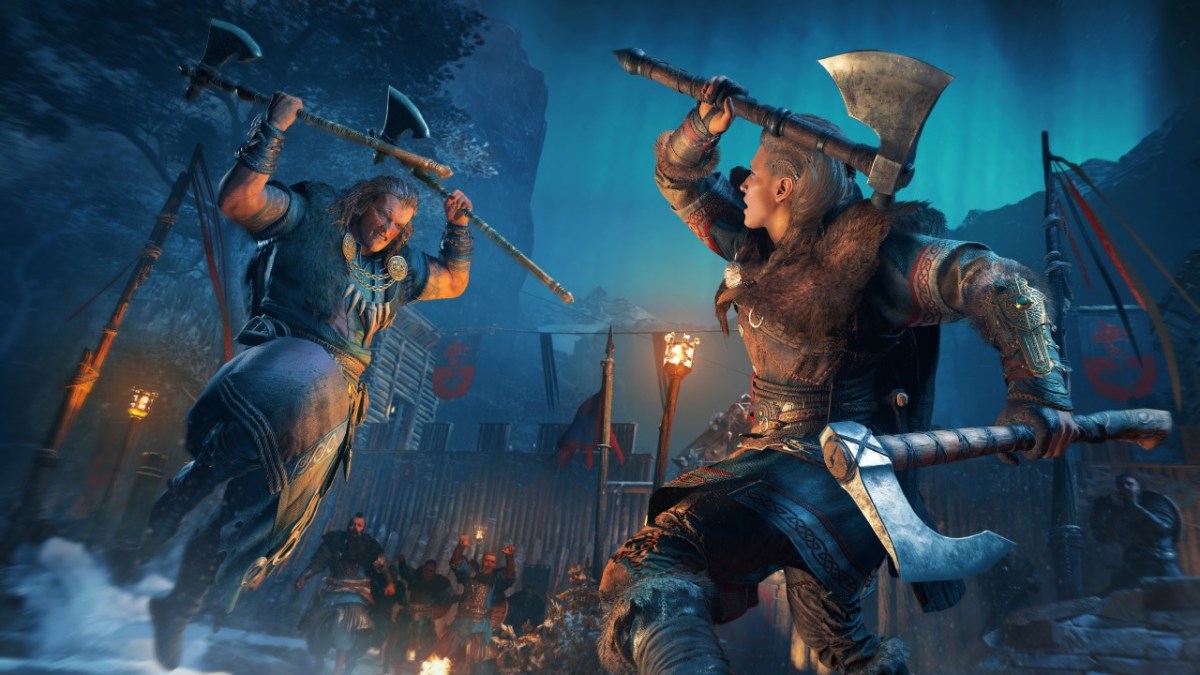Assassin’s Creed Odyssey was a long game, and Assassin’s Creed Valhalla is no different in that regard. I’ve put in well over 70 hours at this point, and I have yet to cross the finish line. That’s still a healthy amount of time, and I’ve seen just about every major system the game has in play (assuming there are no 11th hour surprises). So, while I have yet to officially roll credits, I’ve got plenty of thoughts on Valhalla.
Assassin’s Creed Valhalla is a dense game. Much like the last two games in the franchise – Origins and Odyssey – Valhalla is a massive open-world RPG stuffed to the gills with content. Valhalla is perhaps a larger game than even Odyssey, though I’d argue it has a better variety of activities on offer and its side-stories are better integrated with the main narrative. It’s certainly not an experience you should try and storm through in a week though, unless you hate sleep.
Valhalla is infinitely more enjoyable than the gigantic Odyssey. Assassin’s Creed Valhalla’s England remains a huge area to get lost in, though Ubisoft mercifully saw fit to not map out the entire damned island. It’s a touch absurd I need to breath a sigh of relief they didn’t, yet after Odyssey featured the entirety of Ancient Greece it was a concern. Size wasn’t the only issue with Odyssey’s map: it was filled with similar, routine activities. There’s plenty to love about Odyssey, but I can’t fault anyone who bounced off the game only after a few hours of play.
Assassin’s Creed Valhalla is larger, yet more focused.
Valhalla starts off on a better foot. The game opens with Eivor in Norway, which is a whole open-world segment in and of itself. After a brief introduction in which Eivor rescues herself and her crew from capture you’re set free to explore Norway as you see fit, and are introduced to Assassin’s Creed Valhalla’s improved selection of world activities. Instead of populating the map with a litany of question marks to identify every little lootable item or event, Valhalla has a color-coded set of orbs that represent Wealth, Mysteries, and Artifacts.
Each category is tracked separately on the world map, and standard chests filled with basic upgrade items like leather and iron are divorced from the total completion count. You can zoom in all the way to find and locate these caches of materials, but Valhalla thankfully doesn’t tie them to zone completion. Norway has a healthy selection of each, and it’s here in the cold white north you’re able to sample a little bit of what’s on offer before setting sail for England proper.
Until you approach an orb you won’t know what it is, category aside. In a way this change promotes curiosity and exploration in a way that Odyssey and Origins question marks never did. You never quite know what you’re going to get, and the wider selection of activities on offer means you’re often finding new things to experience out in the world. Wealth markers are a bit of an exception, since these are largely key upgrade items (armor, weapons, and ability books fall within the Wealth category, but the materials are far more common to stumble upon).
You’re not clearing camp after camp after camp, performing the same checklist of tasks at every single pip on the map, which was a problem Odyssey found itself repeating. You could find a pile of stones to build a cairn out of, a parkour puzzle that leads to a fancy new bearded axe, or one of Valhalla’s many quirky “side-quests”, otherwise known as world activities. Rather than fill your quest-log to the brim with side-quests, Valhalla’s world is sprinkled with a smattering of quick, one-shot vignettes that can be completed in roughly ten minutes or less.
The majority of these are utterly bizarre, and provide some much needed levity. Not all of them are winners (one involving viper eggs uses my favorite MMORPG trope of all time: random drops), but they’re far more enjoyable than the smattering of tired, soulless side-quests found in previous games. Throw in flyting (viking rap battles that improve your charisma and open up dialogue options) and the dice-based Orlog, and you’ll find yourself with all sorts of distractions out in the world.

Speaking of more enjoyable, the loot is no longer a deluge of similar items with slightly better stats. Valhalla smartly opts for quality over quantity, and each item you can equip is unique. You can use the items found from Wealth markers in the world to either upgrade your favorites via the blacksmith, or improve their stats overall. This new approach works in large part because Valhalla has dropped the more traditional leveling system found in Origins and Odyssey.
Power is the name of the game in Valhalla. Functionally it’s not all that different from traditional leveling, but Valhalla’s balance is far better under this new Power system than it ever was with a proper level cap. Your Power doesn’t matter much while in Norway, but once you leave and establish your settlement in England you’ll find the nation broken down into different zones that all have recommended Power Levels. Yes, level-gating makes a return, though it’s a little more flexible here.
Whenever you “level” in Valhalla you’re granted two skill points, and once you spend these in the expansive skill tree your Power Level increases. Scaling seems to be based a round a +/-30 window in Valhalla, so a Power Level 60 Eivor can tackle content that’s recommended for Power Level 90. The main narrative rains skill points down upon Eivor’s head, so players worried we were going to have a repeat of Odyssey’s controversial experience gains can rest easy. You can easily pursue just the main story and keep pace.
The skill tree is a mechanical improvement over the Odyssey’s, though it’s also a bit boring. Eivor doesn’t merely gain improved stats from “leveling”: every incremental upgrade to your melee, health, defense, etc. is node within the skill tree, all linked together under three categories. Bear is for melee-focused vikings, Raven stealth, and Wolf ranged. You can respec for free at any time, whether you want to reassign a handful of points or remap the whole tree, which opens the door to more creative play. Nothing too groundbreaking here, but it works well enough to provide a better sense of progression.
The majority of active combat abilities are learned from books tucked away throughout Valhalla (under the Wealth category), meaning the skills left-over for the skill tree are mostly passive. On the one hand, the skill tree when paired with the streamlined equipment allows for better build diversity and more playstyles. On the other, grabbing a +13 increase to health isn’t exactly the most riveting of upgrades. That said, progression does feel snappier thanks in large part to how liberally Valhalla throws skill points at you, so even those more rote choices start to feel like tangible improvements quickly over time.

Combat feels the exact same as it did in Odyssey, even with the added Stamina bar. You’ll block, parry, and dodge between light and heavy attacks, and as you unlock adrenaline bars you’ll weave in those aforementioned combat abilities. Stamina does make combat somewhat more deliberate, but since it’s easily replenished from successful light attacks it’s remarkably easy to ignore in general combat. During one of Valhalla’s many boss battles Stamina comes more into play, as you are forced to dodge or parry your way to victory, but the combat’s weaknesses truly come into the fore during these encounters.
Inputs still feel delayed and mushy, everything feels floaty, and attacks often lack any sense of impact. It can still be fun (wielding a giant two-handed claymore in one hand and a giant great shield in the other is perhaps my favorite weapon combination ever, though dual-shields come close), but it overall devolves into a button-mashing affair where each swing of Eivor’s weapon feels like it’s cutting through empty air, not Saxon flesh.
The so-so combat isn’t enough to rob many of Assassin’s Creed Valhalla’s various activities of their guilty charms. I will never grow tired of smashing the “Raid” button whenever I float near a village or monastery Eivor and their crew can plunder. The fortress assaults that show up in the story are simple, yet I won’t lie and say I didn’t enjoy felling scores of Saxon and Briton forces as my viking horde pushed the line with a battering ram. Combat may not be the greatest, but the encounters outside boss fights still have their charms.
Combat is okay overall, but stealth is far improved. One-hit assassinations make a return (either via a skill in the Raven portion of the skill tree, or a permanent toggle in the Gameplay menu), as does social stealth. 9th century England is littered with settlements and villages that are not openly hostile towards Eivor, but they are wary of the towering Dane. Donning your hood allows you to slink past guards relatively unnoticed, though you can always join a procession of monks or grind some wheat to drop any unwanted attention.
The A.I. isn’t always the sharpest or most consistent, however. Sometimes they’re just not as aware as you’d logically expect, as you stab a sentry and drag their corpse into a bale of hay while their buddy watches. That’s at least comical in some regard, because you can whistle and lure the idiot into the same trap. It’s when the A.I. develops a sixth sense for your presence that stealth gets annoying. By and large this wasn’t a common issue, but for every blind guard who somehow failed to witness their buddy getting murdered by the hay-viking there were two that would spot me a mile away from behind cover.

A Viking Saga, with some Isu flair.
The story is the best we’ve seen from the series since Assassin’s Creed: Black Flag, with a more focused script that flows more succinctly across the game. In Odyssey, the Misthios was on a simple quest to find their family (at least at the start), but the tale often felt like it was plodding along. Valhalla’s story is even longer than Odyssey’s, but thus far it’s been a far, far more entertaining lark. The larger narrative is bolstered by the various zone arcs that make up the bulk of Valhalla’s narrative, and each introduces a cast of characters that are eminently more likeable than anyone I met in Ancient Greece. These arcs all come together in interesting and cohesive ways, and the story constantly feels like it’s moving forward.
Even the actual side-stories that are tied to the main narrative, similar to Odyssey’s First Civilization and Cult of Kosmos arcs, are better woven into the plot. I won’t go into spoilers here, but I will say the Cult system does make a return and it isn’t nearly as bloated. You’ll still have to hunt down clues for some of Eivor’s greatest “hits” list, but the main story does a better job integrating this system within the narrative. It feels less like a separate side-activity that just so happens to have a major impact on the plot, and more like a natural extension of Valhalla’s tale.
Valhalla being an Assassin’s Creed game means there’s some Isu and Modern Day crap to deal with, though I love how the former has been handled. I actually love all the First Civilization insanity, with their Apples of Eden and seeming omnipotence, but their arcs have always been either relegated to ham-fisted plot-twists, or reserved for later DLC. Valhalla weaves the First Civilization storyline into the main narrative in a more alluring and compelling way than any previous Assassin’s Creed game before it, and the story is all the better for it. This aspect of the game is best left unspoiled, but suffice to say I much, much prefer this approach over Odyssey’s, and you should unlock the seer in your settlement as soon as possible.
As for the Modern Day arc with Layla, well, I can either take it or leave it at this rate. While I may love the better integration of the Isu and actual mythology with the main story, I’ve grown weary of the tale set in modern times. Part of this is largely due to how Ubisoft has made this arc optional. Another is how much of it takes place in “cross-media” content like novels and comics, meaning I have to play catch-up with every new Assassin’s Creed title. I just . . . I just don’t care anymore. My opinion on this may change by the end of the game, who knows, but I’m far more interested in Eivor’s tale, the continuing proto-Assassin v. Templar plotline, and Isu stories.
As for the Modern Day arc with Layla, well, I can either take it or leave it at this rate.
But, I have to be blunt: Valhalla’s story is substantially longer than Odyssey’s. Because Ubisoft has better integrated all these once disparate elements into the main plot the story takes upwards of 80 hours to clear. Throw in all the side activities, weapon upgrades, and events tucked away in England, Norway, and elsewhere, and you have a game that exceeds Odyssey in length. It may not be as large a game in scale, but it’s a substantially denser experience.
Look no further than your settlement, which is upgraded over the course of Valhalla. It grows from a longhouse and some shanty tents into a sprawling hub where you’ll return to pick up new story quests, upgrades, and cosmetics. The settlement is a reflection of how far you’ve progressed in Valhalla, and mine is sitting at tier 5 out of 6 after 70 hours of play. Again, Valhalla is perhaps the densest game in the Assassin’s Creed franchise.
It’s also nearly the buggiest, though Unity gets to keep that crown. Perhaps it was the COVID-19 pandemic forcing the team to work from home, but holy Hel does Valhalla have a plethora of small, inane bugs. A.I. pathing straight-up breaking is the most notable and frequent (making the “Play Dead” ability largely useless), but I’ve seen boats floating tens of feet above water jittering in the breeze, peasants jet-skiing across lakes and rivers via their faces as their arms and legs twitch about, and have fallen through the map and lost nearly an hour of progress three times. This was with the day-1 patch mind you. Assassin’s Creed Valhalla often struggles under its own weight, and while none of the bugs I encountered were game-breaking (falling through the world a handful of times aside), they were frequent.
Performance was equally concerning. On an Xbox One X the game tries to maintain 30 frames-per-second, but it often hovers just below that mark. Screen-tearing is constant, and audio frequently cuts out. Facial animations easily shift between good and uncanny within the same cutscene: there’s just a lot of jank here. I get it, this has been a hard year for game development, but the quality-assurance teams clearly needed some extra time with Assassin’s Creed Valhalla. I’ll update this review with my Xbox Series X impressions once my console arrives Tuesday, but I’ve heard even there the game struggles to maintain a solid 60 frames-per-second, which is one of its major selling points on the new console.

The Verdict
And that’s where I’m sitting at the moment. I know the end is in sight, but damn me is Valhalla a dense game, denser than even Odyssey. It doesn’t feel as monotonous or repetitive as Odyssey however, making the longer runtime something I enjoy rather than loathe. In many ways it’s been my favorite game in the series since Black Flag launched seven years ago. England and the other areas are a joy to explore, the skill point oriented Power system makes “leveling” feel less like a barrier than it did before, and the emphasis on unique gear and builds has allowed me to lean into a handful of different playstyles.
But, by Thor’s hammer, is the game janky. Bugs plague the experience, performance is mediocre, but at least it’s pretty! Assassin’s Creed: Valhalla takes all the previous systems introduced in Origins and Odyssey, and streamlines them into a more focused experience. The game may have some flaws, and it’s a shame to see the combat remains mediocre after all these years, yet Valhalla is easily the best entry in the recent trilogy. Grab your axes and shields: it’s time to go a-viking!











Published: Nov 9, 2020 06:57 am